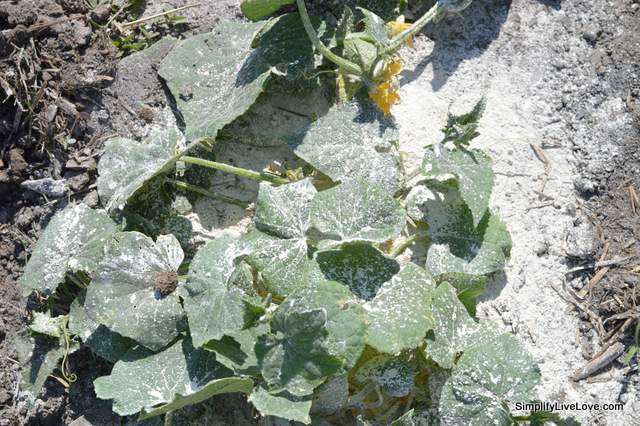How I Got Rid of Cucumber Beetles in My Garden (Naturally & Effectively)
on May 14, 2020, Updated Jul 11, 2025
This post may contain affiliate links. Please read our disclosure policy.
Cucumber beetles have been one of the biggest challenges in my garden. A few years ago, they decimated my cucumbers, squash, and pumpkins—and I’ve been on a mission to control them ever since. After trying many methods, I’ve learned what works and what doesn’t. If you’re trying to save your cucurbit family crops, here’s how to rid of cucumber beetles naturally.
How to Get Rid of Cucumber Beetles
Cucumber beetles destroy cucurbit crops quickly. Catching them early in the growing season is the best way to stop them.
- 🪰 Identify the species of cucumber beetle (striped or spotted)
- 🧼 Hand-pick adult cucumber beetles into a bucket of soapy water
- 🌱 Use floating row covers to protect young plants
- 🟨 Place yellow sticky traps near the base of plants
- 🌿 Apply neem oil or kaolin clay for organic insecticide application
- 🪲 Encourage natural predators like the spined soldier bug and green lacewing
✅ Want to protect your entire garden this year? Learn more about natural pest control techniques here.
Table of Contents

What Are Cucumber Beetles?
Do you see that nasty little yellow and black striped bug on my cucumber plant? They may look all cute and harmless BUT let me tell you, they are real, real pests. They are very destructive.
There are two main types of cucumber beetles I’ve seen in my garden:
- Striped cucumber beetle (Acalymma vittatum): Yellow bodies with black stripes and black heads.
- Spotted cucumber beetle (Diabrotica undecimpunctata): Bright yellow with black spots and yellow abdomen.
They show up early, just as seedlings start growing, and they love cucumbers, zucchini, melons, and pumpkins. I’ve found them chewing through leaves and flowers and laying eggs at the base of my plants. Worse, they spread bacterial wilt, which has killed more than a few of my cucumber plants overnight.

Besides being able to eat cucurbit leaves in a matter of days, they also cause bacterial wilt which kills the plants. I can live in harmony with many bugs, but not these guys. Killing my cucumbers means war, and I am tired of losing that war!! I’ve tried a few things to kill cucumber beetles over the last few years, but nothing’s been successful. Until this year. This year, I caught them early. And I struck hard and I struck fast.

This year, I turned to Diatomaceous Earth. Last year, when I found the dang beetles, I read that food grade Diatomaceous Earth can be used as an organic insecticide, so I ordered a 50 pound bag from Azure Standard. According to the National Pesticide Information Center, Diatomaceous Earth is a type of silica made from the fossilized remains of diatoms. It’s a fine, white powder and it’s edible. Under a microscope, it supposedly looks like shards of glass and it is deadly for any bugs with an exoskeleton, like cucumber beetles, and fleas, and all sorts of nasty parasites. You can read more here at this useful article by Paul Wheaton.
But there are more things you can do to keep these nasty garden pests out of your garden and off your plants.

6 Ways to Kill Cucumber Beetles, Organically
1. Start Monitoring in Early Spring
Now, I check for beetles as soon as my seedlings emerge. I use yellow sticky traps placed near the plants. When I first started doing this, I was shocked by how many beetles I caught.
2. Use Row Covers on Young Plants
I started using row covers after losing an entire early crop to beetles. Row covers have been a game-changer. I keep them on until my plants flower—then I remove them so pollinators can do their job.
Here’s an easy way you can cover a raised garden bed.
3. Trap Crop Strategy
One year, I tried planting Blue Hubbard squash a few weeks before my cucumbers. The beetles went straight for it! I used this trap crop to draw them away from my main garden and hand-picked beetles off the trap plants every morning.
4. Hand-Pick and Use an Insect Vacuum
I don’t love squishing bugs, but hand-picking works. I grab a bucket of soapy water and flick beetles into it early in the day when they’re slower. When the infestation got bad, I borrowed a handheld insect vacuum—it was surprisingly satisfying to use.

5. Apply Organic Treatments
I’ve tried a few different organic sprays:
- Neem oil: I use this as a preventative spray in the early morning.
- Kaolin clay: This coats the leaves with a powdery film that discourages beetles.
- Diatomaceous earth: I sprinkle it around the base of plants and reapply after rain. It seems to help with crawling pests.
6. Support Beneficial Insects
Over time, I’ve worked to attract more beneficial insects. I plant flowers like dill and alyssum to bring in lacewings and soldier bugs. The more natural predators in my garden, the better.
7. Clean Up Garden Debris
I learned the hard way that cucumber beetles overwinter in dead plants and mulch. Now, I clean up everything in the fall and rotate my cucurbit crops each year to avoid giving beetles a home.
8. Companion Planting
Companion plant – certain crops can help repel cucumber beetles. Companion planting can be very effective when done correctly.
- Nasturtiums
- Onions
- Radish
are great plants to include in your cucurbit area to help keep the cucumber beetles at bay. For more companion planting ideas, read this post.
Cautions I have read about DE –
I read not to use the DE on flowering plants as it also kills the bees that pollinate the plants. A very helpful person on my facebook page told me that I can manually pollinate the plants with a Q-Tip, if need be. One of my plants was already flowering and I am spreading the DE anyway. It does have baby cucumbers on it, so we’ll see what happens.
Otherwise, my garden is growing good. I did find one more bad garden pest on my potatoes, and I will tell you about that soon! But everything else is looking really nice.
Have you ever dealt with cucumber beetles? What did you do? And most importantly, how do you stop them from coming back next year? I am really considering burning my garden this year after it’s done.
Welcome to the HOW TO KILL GARDEN PEST SERIES!
Who knew gardeners could take such pleasure in murdering annoying garden pests. If you garden, you’ll want to check out on the posts in this HOW TO KILL series. I’m adding new posts to this series each week, so subscribe to my newsletter if you want to know when they’re ready!
- How to Kill Cucumber Beetles
- How to Kill Potato Beetles
- Murdering Japanese Beetles
- How to Kill Squash Bugs
- Organic Pest Control for Squash Vine Borers
- Tomato Horn Worms – How to Kill!
This post, though, is all about the Cabbage Worm: how to identify, how to kill, how to prevent. So let’s get on with it!














Ooo, will the DE work on ants too do you suppose? Maybe I need to get some. I don’t put down borax because of the cats.
Do post an update about the beetles when you get back! I am interested in hearing how this works out.
As long as ants have an exoskeleton, I guess it would work. I posted a pretty effective homemade ant bait: https://simplifylivelove.com/2013/05/frugal-friday-effective-homemade-ant-bait.html. I’ll let you know how it works out!! Fingers crossed!
@Michelle, a mix of equal parts borax and white sugar will kill ants. They take it to their nest and it kills all.
Have you tried parasitic nematodes? They’re expensive, but I’ve read good things about them.
I have not tried parasitic nematodes but I have read that they work! Thanks for the suggestion.
They are only good for soil dwelling organisms. I am using DE now. I found them early and only a few a day. I crush a group of eggs under a leaf and the adults when I see them. Just dusted today.
how do Striped Cucumber Beetles drink?
It’s good to hear your garden is growing well. The potatoes story must be an interesting one, too.
To minimize impact on honey bees, spread the DE in the evening after the cucumber flowers close for the night. The bees to not typically crawl around on the leaves or ground and the beetles do not infest the flowers much.
I tried food grade DE on my plants last summer and it destroyed my 4 pepper plants, and my mint and tomato lost their leaves and had to struggle back. Definitely interfered with tomato production.
What happened?
Hi Ann, I’ve never heard of that happening with DE. 🙁 Are you sure it was because of the DE? How and where did you apply it?
How often did you have to reapply the DE? How did it work out for the season? I read this today and ran outside to spread the DE as my Zucchinis are affected by the yellow striped bugs. I have DE on hand because I have chickens.
Thanks
Hi Paula, you have to reapply after a rain or every 4-5 days or so. It works well for a while and then I give up, honestly. It just depends on how badly the bugs have infected your plants before you start. If I catch them quickly and treat early I have much more success than if they get out of hand before I do anything. Good luck!!
I’ve used DE on all my plants to control aphids (particularly on my pepper plants), leafhoppers, and now cucumber beetles. I have never had it harm any plant whatsoever. I live on a farm in the Texas panhandle, and am surrounded by wheat and corn crops; and also have a pasture that naturally grows buffalo gourds (which grow from enormous tubers and spread like wildfire if attempted to dig up). The buffalo gourds stay covered in cucumber beetles, which I felt was luring in the beetles closer to my garden ( I’ve now decided it’s likely irrelevant after keeping them torched to the ground multiple seasons and still fighting cucumber beetles like crazy). I use row covers, companion plants, & surround, which works very well, but requires reqular reapplication to new growth and after rains; and is just Extremely messy, but it is the only way I’ve found to have any kind of cuc/pumpkin harvest. This year, after still loosing my pumpkin plants last year to bacterial wilt, I’ve decided to grow these plants in my greenhouse and hand pollinate. I’m using the DE in the greenhouse heavily, as yes; I’ve still caught a couple beetles inside the greenhouse. I have not applied the surround yet, if I can keep things under control with the DE (hoping). I love spinosad for many pests, but for the level of beetles I have, it’s simply not effective (Captain Jack’s dead bug brew and fertilome brands). I’ve also used peppermint oil diluted as a spray which the plant leaves did seem to love, but not effective with beetle war and counter productive if using surround or DE. Traps/lures also found to be useless (caught a couple, but hundreds on plants). Greatest of luck to anyone else struggling with these demons!
Thanks for your perspective. They really are the most horrid of all garden pests that I’ve dealt with. Hope the greenhouse growing goes well! <3
Going from a large number to just around ten is quite the accomplishment. It must have really startled you when you saw the masses for the first time.
Going from a large number to just around ten is quite the accomplishment. It must have really startled you when you saw the large group for the first time.
What a quick and simple way to get rid of such a destructive insect! Thanks for providing the safety tips for handling DE as well, you definitely don’t want to end up hospitalized for making such a simple mistake. Great guide!
you can try salt. 1 liter water and 1/2 teaspoon of salt. then spray it every morning. Salt is also source of nitrogen and its good for plants
Salt is Sodium Chloride, which has no nitrogen at all. Are you perhaps confusing the chemical symbol Na (sodium) with N (nitrogen)? Most plants have tolerance only to a small amount of salt and overdoing it could easily mess up the carefully balanced pathways of water and nutrients in the root system.
With the nationwide demise of important bees, I can’t fathom how you can advise people to just overlook the fact that their use of DE will further destroy local bees populations. And of course, dead-no bees in your garden means no fruit. Is this really the most thoughtful and educated approach to gardening? Golly.
My thoughts exactly!
After cucumbers coming out my ears for two months cucumber beetles put the skids to production . I have been spraying with water & Dawn every evening & it is helping. Watch my butternuts like a hawk & kill all I can find. Will be burning EVERYTHING from the garden as it is done!